2022
Macroscopic hyperpolarization enhanced with quantum optimal control, A. Marshall, T. Reisser, P. Rembold, Ch. Müller, J. Scheuer, M. Gierse, T. Eichhorn, J. M. Steiner, P. Hautle, T. Calarco, F. Jelezko, M.B. Plenio, S. Montangero, I. Schwartz, M. M. Müller, and Ph. Neumann, Phys. Rev. Res. 4, 043179
Hyperpolarization of nuclear spins enhances nuclear magnetic resonance signals, which play a key role for imaging and spectroscopy in the natural and life sciences. This signal amplification unlocks previously inaccessible techniques, such as metabolic imaging of cancer cells. In this paper, electron spins from the photoexcited triplet state of pentacene-doped naphthalene crystals are used to polarize surrounding protons. As existing strategies are rendered less effective by experimental constraints, they are replaced with optimal control pulses designed with redcrab. In contrast to previous optimal control approaches, which consider one or two effective nuclei, this closed-loop optimization is macroscopic. A 26% improvement in signal and 15% faster polarization rate are observed. Additionally, a strategy called autonomously optimized repeated linear sweep (ARISE) is introduced to efficiently tailor existing hyperpolarization sequences in the presence of experimental uncertainty to enhance their performance. ARISE is expected to be broadly applicable in many experimental settings.
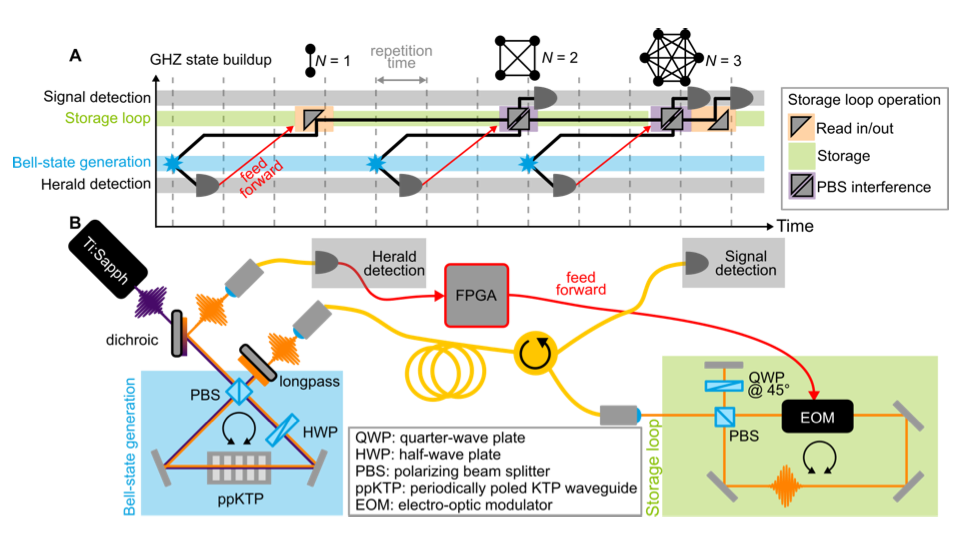
Scalable Generation of Multiphoton Entangled States by Active Feed-Forward and Multiplexing, Evan Meyer-Scott, Nidhin Prasannan, Ish Dhand, Christof Eigner, Viktor Quiring, Sonja Barkhofen, Benjamin Brecht, Martin B. Plenio, and Christine Silberhorn, Phys. Rev. Lett. 129, 150501, arXiv:1908.05722
Multiphoton entangled quantum states are key to advancing quantum technologies such as multiparty quantum communications, quantum sensing, or quantum computation. Their scalable generation, however, remains an experimental challenge. Current methods for generating these states rely on stitching together photons from probabilistic sources, and state generation rates drop exponentially in the number of photons. Here, we implement a system based on active feed-forward and multiplexing that addresses this challenge. We demonstrate the scalable generation of four-photon and six-photon Greenberger-Horne-Zeilinger states, increasing generation rates by factors of 9 and 35, respectively. This is consistent with the exponential enhancement compared to the standard nonmultiplexed approach that is predicted by our theory. These results facilitate the realization of practical multiphoton protocols for photonic quantum technologies.
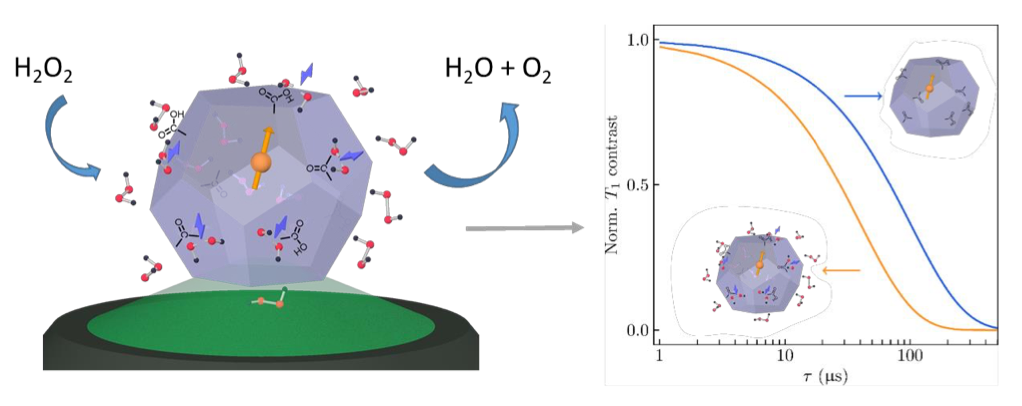
Detection of Few Hydrogen Peroxide Molecules Using Self-Reporting Fluorescent Nanodiamond Quantum Sensors, Y. Wu, P. Balasubramanian, Z.-Y. Wang, J.A.S. Coelho, M. Prslja, M.B. Plenio, F. Jelezko, T. Weil., JACS 144, 12642
Hydrogen peroxide (H2O2) plays an important role in various signal transduction pathways and regulates important cellular processes. However, monitoring and quantitatively assessing the distribution of H2O2 molecules inside living cells requires a nanoscale sensor with molecular-level sensitivity. Herein, we show the first demonstration of sub-10 nm-sized fluorescent nanodiamonds (NDs) as catalysts for the decomposition of H2O2 and the production of radical intermediates at the nanoscale. Furthermore, the nitrogen-vacancy quantum sensors inside the NDs are employed to quantify the aforementioned radicals. We believe that our method of combining the peroxidase-mimicking activities of the NDs with their intrinsic quantum sensor showcases their application as self-reporting H2O2 sensors with molecular-level sensitivity and nanoscale spatial resolution. Given the robustness and the specificity of the sensor, our results promise a new platform for elucidating the role of H2O2 at the cellular level.
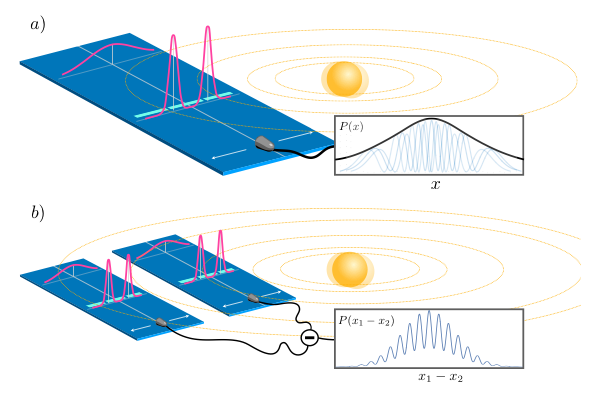
Robust macroscopic matter-wave interferometry with solids, Julen S. Pedernales and Martin B. Plenio, Phys. Rev. A 105, 063313, arXiv:2107.14794
Matter-wave interferometry with solids is highly susceptible to minute fluctuations of environmental fields, including gravitational effects from distant sources. Hence, experiments require a degree of shielding that is extraordinarily challenging to achieve in realistic terrestrial or even space-based setups. Here, we design protocols that exploit the spatial correlations that are inherent in perturbations due to distant sources to reduce significantly their impact on the visibility of interference patterns. We show that interference patterns that are robust to such type of noise can be encoded in the joint probability distribution of two or more interferometers, provided that these are initialized in suitable states. We develop a general framework that makes use of N+1 interferometers, which may differ in their masses, to correct for environmental potential fields up to order N in their multipole expansion. Remarkably, our approach works for fields that fluctuate stochastically in any timescale and does not require the presence of quantum correlations among the different interferometers. Finally, we also show that the same ideas can be extended to the protection of entanglement between pairs of interferometers.
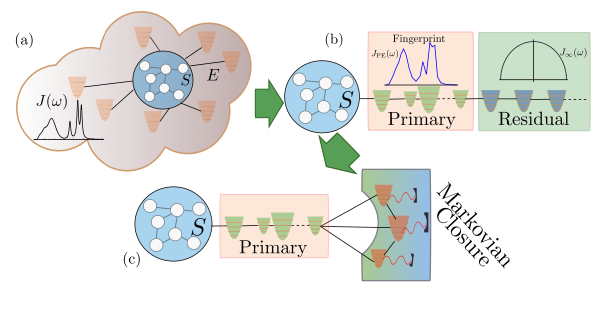
Fingerprint and Universal Markovian Closure of Structured Bosonic Environments, A. Nüßeler, D. Tamascelli, A. Smirne, J. Lim, S.F. Huelga, and M.B. Plenio, Phys. Rev. Lett. 129, 140603, arXiv:2208.01978v2
We exploit the properties of chain mapping transformations of bosonic environments to identify a finite collection of modes able to capture the characteristic features, or fingerprint, of the environment. Moreover we show that the countable infinity of residual bath modes can be replaced by a universal Markovian closure, namely, a small collection of damped modes undergoing a Lindblad-type dynamics whose parametrization is independent of the spectral density under consideration. We show that the Markovian closure provides a quadratic speedup with respect to standard chain mapping techniques and makes the memory requirement independent of the simulation time, while preserving all the information on the fingerprint modes. We illustrate the application of the Markovian closure to the computation of linear spectra but also to nonlinear spectral response, a relevant experimentally accessible many body coherence witness for which efficient numerically exact calculations in realistic environments are currently lacking.
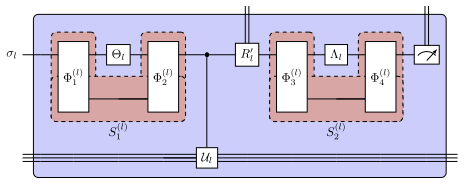
Coherence as a Resource for Shor’s Algorithm, Felix Ahnefeld, Thomas Theurer, Dario Egloff, Juan Mauricio Matera, and Martin B. Plenio, Phys. Rev. Lett. 129, 12050
Shor’s factoring algorithm provides a superpolynomial speedup over all known classical factoring algorithms. Here, we address the question of which quantum properties fuel this advantage. We investigate a sequential variant of Shor’s algorithm with a fixed overall structure and identify the role of coherence for this algorithm quantitatively. We analyze this protocol in the framework of dynamical resource theories, which capture the resource character of operations that can create and detect coherence. This allows us to derive a lower and an upper bound on the success probability of the protocol, which depend on rigorously defined measures of coherence as a dynamical resource. We compare these bounds with the classical limit of the protocol and conclude that within the fixed structure that we consider, coherence is the quantum resource that determines its performance by bounding the success probability from below and above. Therefore, we shine new light on the fundamental role of coherence in quantum computation.
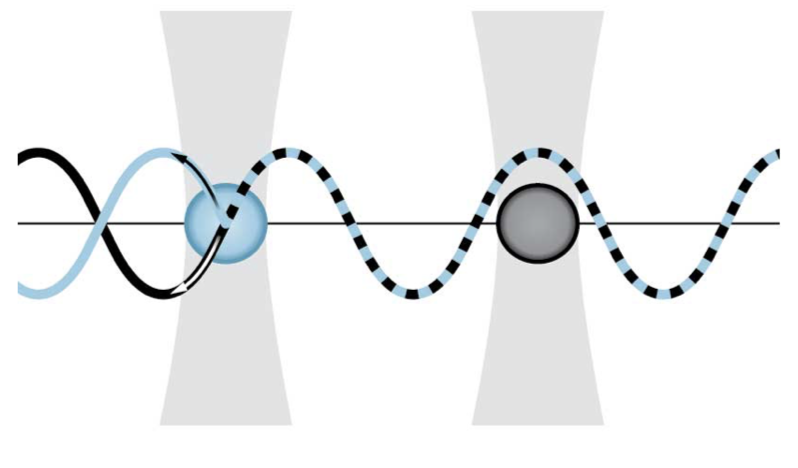
Two nanoparticles dancing as a pair, Julen S. Pedernales, Science 377 (6609), 921-922 (2022)
That light can move matter should not come as a surprise to anyone. Scientists have considered this since 1619, when Johannes Kepler suggested that the tails of comets are pointing away from the Sun because of the force exerted on them by the sunlight. By the 1970s, scientists had figured out how to use laser beams to push, pull, and trap nano- and microscale objects. Using the same physical principles, light can also induce interactions between particles that would not otherwise “sense” the presence of each other. On page 987 of issue 6609 of Science magazine, Rieser et al. report an experimental demonstration of such a light-induced interaction between two silica nanoparticles suspended in a vacuum and show that the trapping laser beams can be used as a control to tune the form and strength of the coupling. In this perspective article, we comment on the implications of this cutting-edge experimental result.
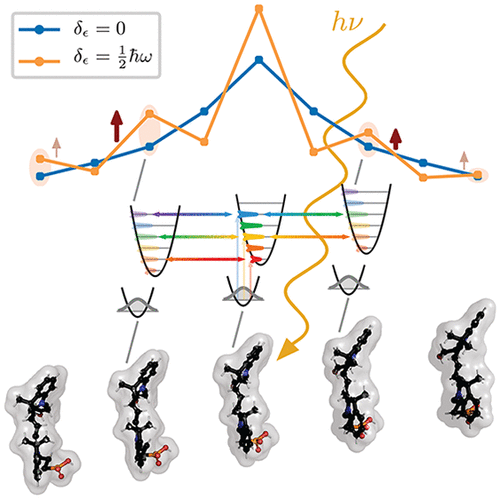
Long-Range Nonequilibrium Coherent Tunneling Induced by Fractional Vibronic Resonances, R. Kevin Kessing, Pei-Yun Yang, Salvatore R. Manmana, and Jianshu Cao, J. Phys. Chem. Lett. 2022, 13, XXX, 6831–6838
When exposed to visible-range light, many organic molecules are excited from their electronic ground state to an electronically excited state. Such electronic excitations can travel from one molecule to neighboring molecules (via dipole–dipole coupling, for instance), and in addition, such electronic excitations often mingle with the molecular structure in a way that couples electronic excitations to vibrational excitations. We uncovered that if the energy quantum of such molecular vibrations is equal to a simple rational multiple of an applied energy potential, then the intermolecular energy transport is strongly promoted via long-ranged tunneling resonances.
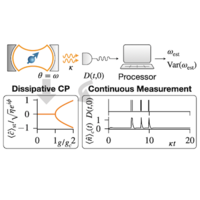
Criticality-Enhanced Quantum Sensing via Continuous Measurement, Theodoros Ilias, Dayou Yang, Susana F. Huelga, and Martin B. Plenio, PRX Quantum 3, 010354
Present protocols of criticality-enhanced sensing with open quantum sensors assume direct measurement of the sensor and omit the radiation quanta emitted to the environment, thereby potentially missing valuable information. Here we propose a protocol for criticality-enhanced sensing via continuous observation of the emitted radiation quanta. Under general assumptions, we establish a scaling theory for the global quantum Fisher information of the joint system and environment state at dissipative critical points. We derive universal scaling laws featuring transient and long-time behavior governed by the underlying critical exponents. Importantly, such scaling laws exceed the standard quantum limit and can in principle saturate the Heisenberg limit. To harness such advantageous scaling, we propose a practical sensing scheme based on continuous detection of the emitted quanta as realized experimentally in various quantum-optical setups. In such a scheme a single interrogation corresponds to a (stochastic) quantum trajectory of the open system evolving under the nonunitary dynamics dependent on the parameter to be sensed and the backaction of the continuous measurement. Remarkably, we demonstrate that the associated precision scaling significantly exceeds that based on direct measurement of the critical steady state, thereby establishing the metrological value of the continuous detection of the emitted quanta at dissipative criticality. We illustrate our protocol via counting the photons emitted by the open Rabi model, a paradigmatic model for the study of dissipative phase transition with finite components. Our protocol is applicable to generic quantum-optical open sensors permitting continuous readout, and may find applications at the frontier of quantum sensing, such as the human-machine interface, magnetic diagnosis of heart disease, and zero-field nuclear magnetic resonance.
Exact simulation of pigment-protein complexes unveils vibronic renormalization of electronic parameters in ultrafast spectroscopy, F. Caycedo-Soler, A. Mattioni, J. Lim, T. Renger, S. F. Huelga, and M. B. Plenio, Nat Commun 13, 2912 (2022)
The search for the design principles of photosynthesis, a remarkably optimized natural process, is attracting considerable interest in the physics, chemistry and biology communities. Recent advances of spectroscopic techniques have provided a huge amount of spectroscopic data and paved the way to quantitatively investigate photosynthetic energy and charge transport. However, the presence of quasi-continuous protein vibrational spectrum and a large number of underdamped intra-pigment modes makes it challenging to consider realistic vibrational structures in the analysis of spectroscopic data due to a lack of efficient numerically exact simulation tools. Indeed, for realistic photosynthetic systems the application of current state-of-the-art methods carries a prohibitive cost even for a minimal dimeric system. As a result, the experimental data are currently interpreted based on significantly simplified reduced models of the highly structured vibrational environments of photosynthetic systems.
One of the most widely used reduced models takes into account the quasi-continuous protein spectrum only, as the electronic-vibrational (vibronic) coupling of an individual intra-pigment mode is small. Such a reduced model approach has been employed to analyze linear absorption spectra in order to estimate electronic parameters, determining the design principles of photosynthetic systems. This reduced model has been considered to interpret long-lived oscillations observed in multidimensional nonlinear spectra [Engel et al., Nature 446, 782 (2007), Lee et al., Science 316, 1462 (2007), Collini et al, Nature 463, 644 (2010)], whose discovery was a key driver for the emergence of the field of quantum biology. On the basis of this model it has been claimed that the observed oscillating signals originate from purely electronic coherences protected by proteins and photosynthetic energy transfer may be coherent.
The current debate regarding the microscopic origin of long-lived quantum effects in photosynthetic systems has been initiated from a more sophisticated reduced model where a few selected intra-pigment modes whose frequencies are near resonant with excitonic splittings are considered in addition to the quasi-continuous protein spectrum. Based on this minimal vibronic model, it has been claimed that the weakly coupled resonant intra-pigment modes may not modify linear optical spectra and therefore do not affect the electronic parameter estimation, but multidimensional nonlinear experiments are sensitive enough to observe coherent effects induced by the underdamped intra-pigment modes. As recently reviewed by [Cao et al., Science Advances 6, eaaz4888 (2020)], the minimal vibronic model has been employed to interpret long-lived oscillatory nonlinear signals, although theoretical predictions agree poorly with experimental results.
A major obstacle that prevents the conclusive resolution of this debate in the field of quantum biology, and more generally, the unambiguous identification of the design principles of photosynthetic systems is the fact that the interpretation of spectroscopic data is significantly influenced by the electronic and vibrational parameters considered in the analysis. In our work, we address this challenge with new quantitative methods and provide, for the first time, numerically exact simulations of spectroscopic data for two distinct model photosynthetic systems, the water-soluble chlorophyll-binding protein of cauliflower and the special pair in bacterial reaction centers, to demonstrate that the actual vibrational environments of photosynthetic systems affects significantly the interpretation of spectroscopic data and consequently of the underlying energy transfer dynamics. By considering experimentally estimated vibrational environments without any approximations, we identify a new theoretical phenomenon, called a multi-mode vibronic mixing, which significantly modifies both linear and nonlinear optical spectra. We show that even if an individual intra-pigment mode is weakly coupled to electronic states, the cumulative effect of the several tens of intra-pigment modes, present in real systems, can significantly shift the energy-gaps between absorption peaks. This in turn implies that the electronic parameters estimated by conventional approaches based on the reduced models are not reliable and may differ by 50 % or more. This suggests the possibility that our understanding of photosynthetic energy transfer may be significantly changed when the electronic couplings are re-estimated based on the actual environmental structures. More importantly, we demonstrate that the coherence time of photosynthetic energy transfer is strongly enhanced when the full environments are considered, compared to the prediction of the conventional approaches where only a few resonant intra-pigment modes are considered with the protein spectrum. We also demonstrate that such long-lived quantum coherences induced by the multi-mode vibronic mixing can result in long-lived oscillatory signals in multidimensional nonlinear spectra, which cannot be described by the conventional approaches and has not been considered in the analysis of experimental data reported in literature.

Entanglement and Superposition Are Equivalent Concepts in Any Physical Theory, Guillaume Aubrun, Ludovico Lami, Carlos Palazuelos, and Martin Plávala, Phys. Rev. Lett. 128, 160402, arXiv
We prove that given any two general probabilistic theories (GPTs) the following are equivalent: (i) each theory is nonclassical, meaning that neither of their state spaces is a simplex; (ii) each theory satisfies a strong notion of incompatibility equivalent to the existence of “superpositions”; and (iii) the two theories are entangleable, in the sense that their composite exhibits either entangled states or entangled measurements. Intuitively, in the post-quantum GPT setting, a superposition is a set of two binary ensembles of states that are unambiguously distinguishable if the ensemble is revealed before the measurement has occurred, but not if it is revealed after. This notion is important because we show that, just like in quantum theory, superposition in the form of strong incompatibility is sufficient to realize the Bennett-Brassard 1984 protocol for secret key distribution.
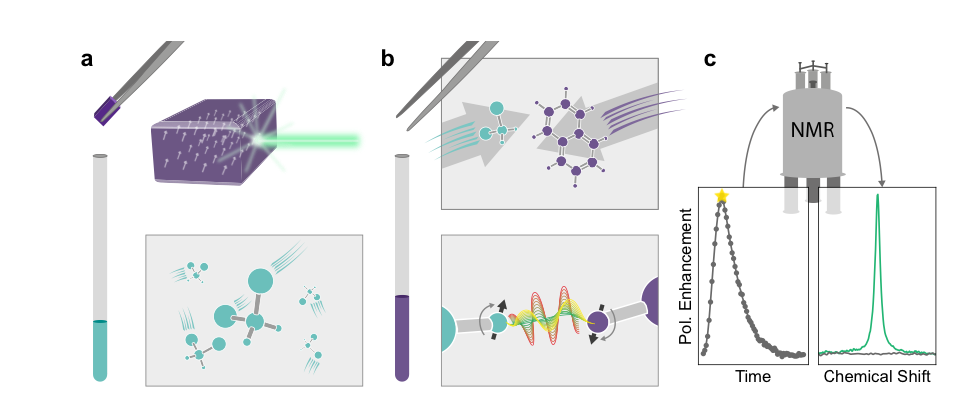
Hyperpolarized Solution-State NMR Spectroscopy with Optically Polarized Crystals, T.R. Eichhorn, A.J. Parker, F. Josten, Ch. Müller, J. Scheuer, J. Steiner, M. Gierse, J. Handwerker, M. Keim, S. Lucas, M.U. Qureshi, A. Marshall, A. Salhov, J. Binder, K. Jahnke, P. Neumann, S. Knecht, J.W. Blanchard, M.B. Plenio, F. Jelezko, L. Emsley, C.C. Vassiliou, P. Hautle, and I. Schwartz. J. Am. Chem. Soc. 2022, 144, 6, 2511–2519, arXiv:2108.06147
Nuclear spin hyperpolarization provides a promising route to overcome the challenges imposed by the limited sensitivity of nuclear magnetic resonance. Here we demonstrate that dissolution of spin-polarized pentacene-doped naphthalene crystals enables transfer of polarization to target molecules via intermolecular cross-relaxation at room temperature and moderate magnetic fields (1.45 T). This makes it possible to exploit the high spin polarization of optically polarized crystals, while mitigating the challenges of its transfer to external nuclei. With this method, we inject the highly polarized mixture into a benchtop NMR spectrometer and observe the polarization dynamics for target 1H nuclei. Although the spectra are radiation damped due to the high naphthalene magnetization, we describe a procedure to process the data to obtain more conventional NMR spectra and extract the target nuclei polarization. With the entire process occurring on a time scale of 1 min, we observe NMR signals enhanced by factors between −200 and −1730 at 1.45 T for a range of small molecules.
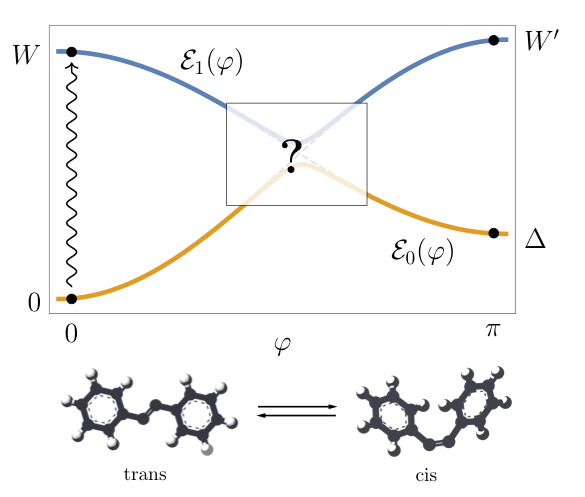
Capacity of non-Markovianity to boost the efficiency of molecular switches, Giovanni Spaventa, Susana F. Huelga, and Martin B. Plenio, Phys. Rev. A 105, 012420
Quantum resource theory formulations of thermodynamics offer a versatile tool for the study of fundamental limitations to the efficiency of physical processes, independently of the microscopic details governing their dynamics. Despite the ubiquitous presence of non-Markovian dynamics in open quantum systems at the nanoscale, rigorous proofs of their beneficial effects on the efficiency of quantum dynamical processes at the molecular level have not been reported yet. Here we combine the quantum resource theory of athermality with concepts from the theory of divisibility classes of quantum channels to prove that memory effects can increase the efficiency of photoisomerization to levels that are not achievable under a purely thermal Markovian (i.e., memoryless) evolution. This provides rigorous evidence that memory effects can provide a resource in quantum thermodynamics at the nanoscale.

Enhancing Gravitational Interaction between Quantum Systems by a Massive Mediator, Julen S. Pedernales, Kirill Streltsov and Martin B. Plenio, Phys. Rev. Lett. 128, 110401 (2022), arXiv
A revised experimental arrangement could significantly boost the generation of quantum correlations between particles that interact only gravitationally thus boosting the prospects of testing the quantumness of gravity with tabletop experiments. Consider two particles levitated in vacuum and prepared in a quantum superposition which are let to interact gravitationally for a time long enough to correlate significantly theirmechanical degrees of freedom. A specific type of correlation, called quantum correlation or entanglement, is incompatible with the notion of a classical gravitational field mediating the interaction, that is, with a field that takes a definite value at each point in space. Thus, the observation of such quantum correlations, which can be detected by measuring the position and momentum of the test particles, would rule out classical theories of gravity, and advocate in favor of a quantum description. The difficulty in realising such a test lies in the necessity of preparing massive particles in a quantum superposition for a time sufficiently long to build detectable correlations. In their recent work, Pedernales et al. prove that such an experiment can be performed in significantly shorter time scales by introducing a third larger mass that interacts with the test particles. This revised arrangement is able to leverage the larger gravitational pull of the mediator mass and considerably enhance the rate at which quantum correlations are built between the test particles. The remarkable aspect of their result is that, under suitable conditions, the large mass does not need to be prepared in a pure quantum state, immediately augmenting the range of masses available for this type of experiments with the same technological capabilities.
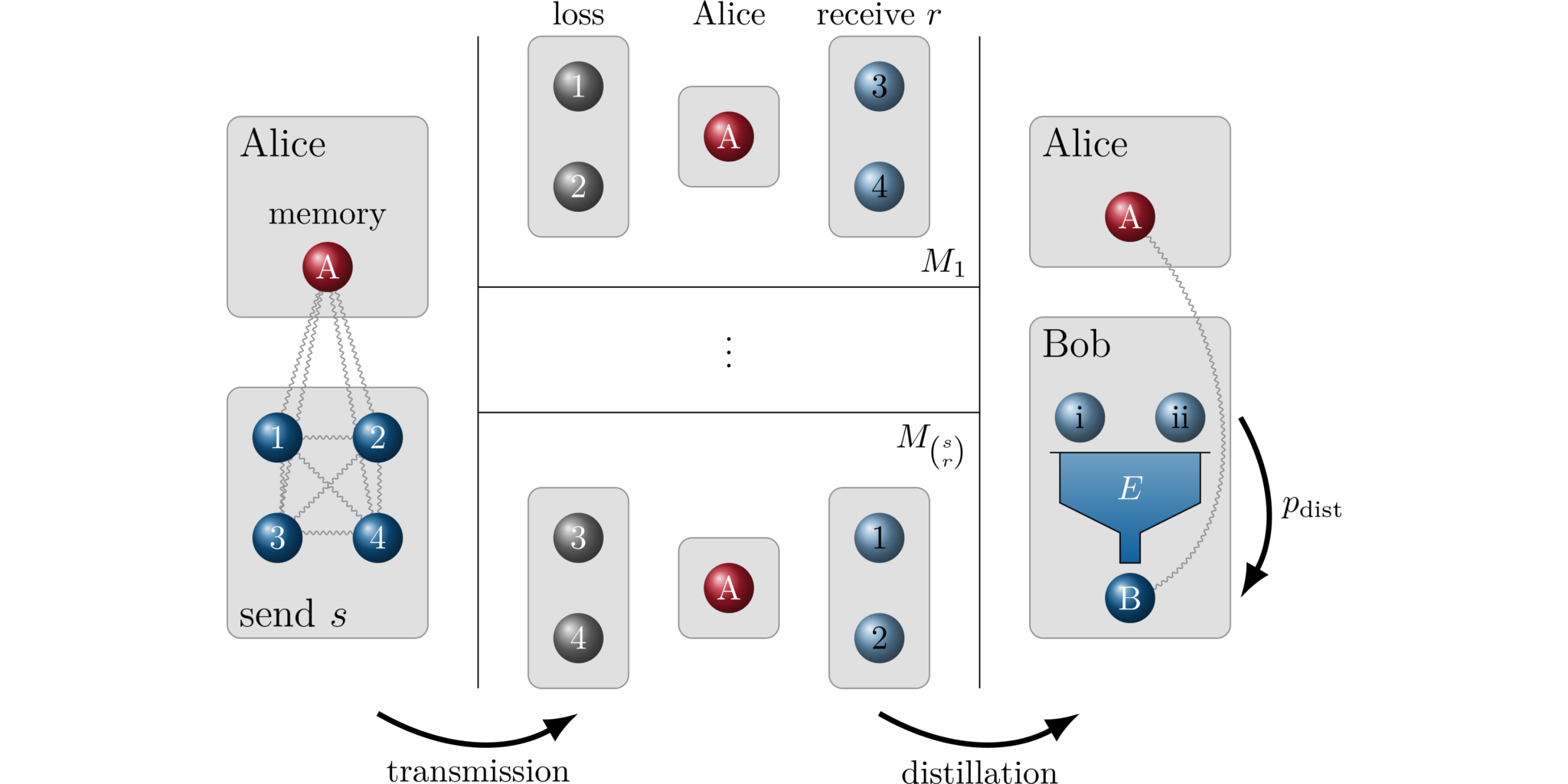
Optimizing quantum codes with an application to the loss channel with partial erasure information, Benjamin Desef and Martin B. Plenio, Quantum 6, 667 (2022)
We investigate how we can use numerics to construct quantum encodings that can protect against losses in an optimal way - both probabilistically and deterministically. For this hard problem, which involves a joint optimization both over an optimal encoded state as well as its optimal decoder, we develop various algorithms that provide convincing results. This is a first step in dealing with the problem, as we restrict ourselves to permutationally-invariant subspaces (allowing to scale the problem to a large number of photons); in subsequent work, we will improve on this restriction.
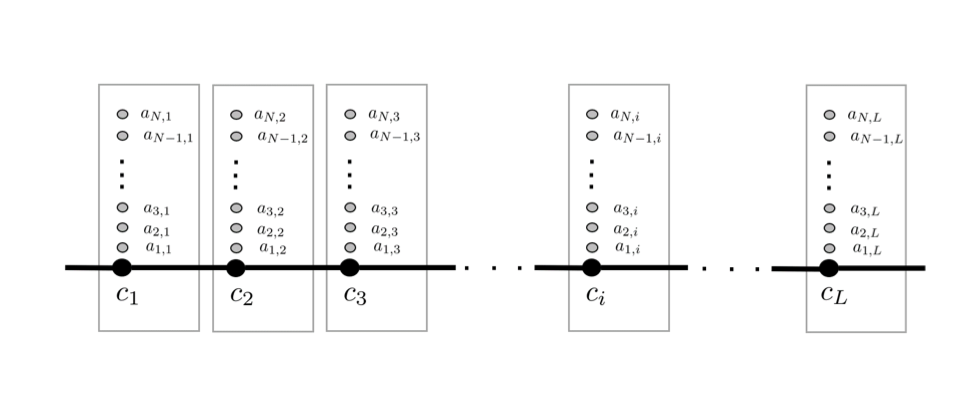
Entanglement spectrum in general free fermionic systems, Eldad Bettelheim, Aditya Banerjee, Martin B. Plenio, and Susana F. Huelga, J. Phys. A: Math. Theor. 55 135001
The statistical mechanics characterization of finite subsystems embedded in an infinite system is a fundamental question of quantum physics. Nevertheless, a full closed form for all required entropic measures does not exist in the general case, even for free systems, when the finite system in question is composed of several disjoint intervals. Here we develop a mathematical framework based on the Riemann–Hilbert approach to treat this problem in the one-dimensional case where the finite system is composed of two disjoint intervals and in the thermodynamic limit (both intervals and the space between them contains an infinite number of lattice sites and the result is given as a thermodynamic expansion). To demonstrate the usefulness of our method, we compute the change in the entanglement and negativity spectra namely the spectrum of eigenvalues of the reduced density matrix with or without time reversal of one of the intervals. We do this in the case that the distance between the intervals is much larger than their size. The method we use can be easily applied to compute any power in an expansion in the ratio of the distance between the intervals to their size. We expect these results to provide the necessary mathematical apparatus to address relevant questions in concrete physical scenarios, namely the structure and extent of quantum correlations in fermionic systems subject to local environments.
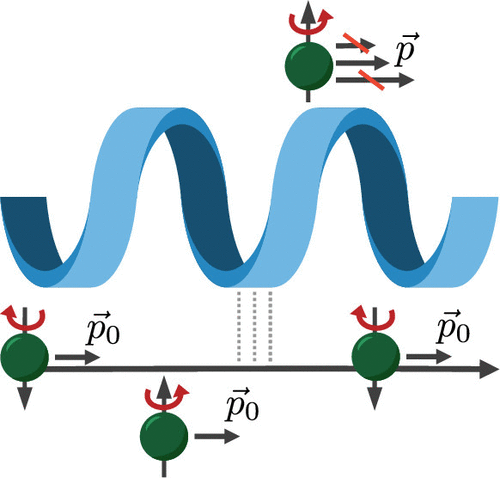
Interface-Induced Conservation of Momentum Leads to Chiral-Induced Spin Selectivity, Clemens Vittmann, R. Kevin Kessing, James Lim, Susana F. Huelga, and Martin B. Plenio, J. Phys. Chem. Lett. 2022, 13, 7, 1791–1796, arXiv
We study the non-equilibrium dynamics of electron transmission from a straight waveguide to a helix with spin-orbit coupling. Transmission is found to be spin-selective and can lead to large spin polarizations of the itinerant electrons. The degree of spin selectivity depends on the width of the interface region, and no polarization is found for single-point couplings. We show that this is due to momentum conservation conditions arising from extended interfaces. We therefore identify interface structure and conservation of momentum as crucial ingredients for chiral-induced spin selectivity, and confirm that this mechanism is robust against static disorder.
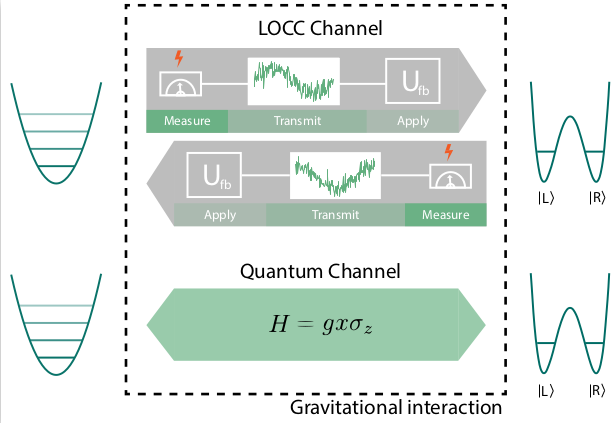
On the Significance of Interferometric Revivals for the Fundamental Description of Gravity, K. Streltsov, J. S. Pedernales, and M. B. Plenio, Universe, 8, 58 (2022), arXiv
Can the interferometric signal of a two-level system that is interacting with an oscillator be used to determine whether the field mediating the interaction requires a quantum description as suggested by a recent proposal? In this work we show that this is not the case and suggest an alternative route highlighting its connection to black hole physics.
Contact


Ulm University
Institute of Theoretical Physics
Albert-Einstein-Allee 11
D - 89081 Ulm
Germany
Tel: +49 731 50 22911
Fax: +49 731 50 22924
Office: Building M26, room 4117
Click here if you are interested in joining the group.
Most Recent Papers
Efficient Information Retrieval for Sensing via Continuous Measurement, Phys. Rev. X 13, 031012, arXiv:2209.08777
Active hyperpolarization of the nuclear spin lattice: Application to hexagonal boron nitride color centers, Phys. Rev. B 107, 214307, arXiv:2010.03334
Driving force and nonequilibrium vibronic dynamics in charge separation of strongly bound electron–hole pairs, Commun Phys 6, 65 (2023), arXiv:2205.06623
Asymptotic State Transformations of Continuous Variable Resources, Commun. Math. Phys. 398, 291–351 (2023), arXiv:2010.00044
Spin-Dependent Momentum Conservation of Electron-Phonon Scattering in Chirality-Induced Spin Selectivity, J. Phys. Chem. Lett. 2023, 14, XXX, 340–346, arXiv:2209.05323
